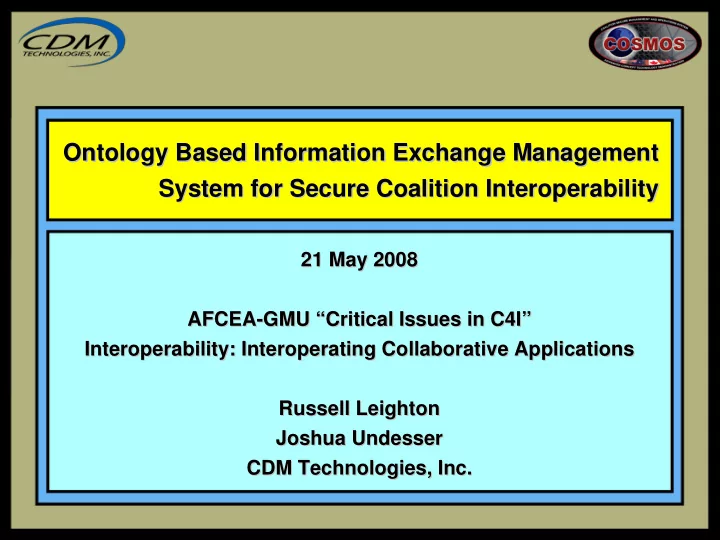

Ontology Based Information Exchange Management Ontology Based Information Exchange Management System for Secure Coalition Interoperability System for Secure Coalition Interoperability 21 May 2008 21 May 2008 AFCEA-GMU “Critical Issues in C4I” AFCEA-GMU “Critical Issues in C4I” Interoperability: Interoperating Collaborative Applications Interoperability: Interoperating Collaborative Applications Russell Leighton Russell Leighton Joshua Undesser Joshua Undesser CDM Technologies, Inc. CDM Technologies, Inc.
Background • Coalition Secure Management and Operations System (COSMOS) – Multilateral Interoperability Programme (MIP) • Command and Control Information Exchange Data Model (C2IEDM) • Data Exchange Mechanism (DEM) – Constrained Information Exchange Based on Role • Information Exchange Requirements (IER) • Constraint Model for Concise IER Definition and Assessment
Background • COSMOS Primary Objectives – To provide an acceptable level of security to the MIP data exchange environment – To reduce the volume of data that currently flows through MIP nodes – To allow Information Management Officers to tailor the data exchange at a finer level of granularity – To explore the potential capabilities and limitations of agent technology at higher levels of security control
MIP Exchange Nation 1 Nation 2 Friendly Neutral Contracts on FRDNEU Org Nation 3 Correlated Contract on CORENU Enemy
COSMOS Exchange Nation 1 Nation 2 Nation 2 Friendly Role IER Neutral Org Nation 3 Nation 3 Role IER Correlated Enemy
Enabling Technologies • Knowledge Management Framework – Service Oriented Architecture – Collaborative decision-support (agents and users) – High-level information representation (ontology) – Common services (distributable software modules/reuse) • Distributed Information Management – Modular service and de-coupled applications allow flexibility in system deployment (platform independence) – Information location transparency • System Interoperability – Access any information domain using structured data format – Information mapping to alternative views
Foundational Concepts • Ontology – High level information representation defining structural hierarchy, characteristics, and relationships (object model) as well as inherent behavior and semantics (logic). • Agent – Software entity capturing domain logic/expertise (behavior and semantics). Provides feedback in response to satisfaction of logical conditions enabling collaborative decision support. • Information Exchange Requirement (IER) – Basic definition of a specific kind of information required to perform a particular activity or function. The requirement specification may be associated with one or more conditions that when satisfied trigger an appropriate information exchange action. • Role – Activity or function assumed by an operational unit. May be used to establish an entity fulfilling a particular role with its basic set of information requirements.
Key Processes • Define Role/Task Information Requirements – Select IER criteria based on pre-defined/similar roles or tasks – Define/modify IER criteria composed of information value constraints (patterns) • Assess Information Exchange Requirements – Evaluate national C2 information against coalition exchange requirements – Recommend exchange of information satisfying IER criteria through inclusion in relevant Information Group • Monitor Information Exchange – Provide reports on node/contract/group activity – Validate incoming information against exchange requirements
System Architecture
System Architecture Information Management Framework: • Provides collaborative, distributed, information services infrastructure Exchange C2 Domain Control Domain
System Architecture Interoperability Bridge: • Provides information mapping service with connections to DEM and DSL service interfaces
System Architecture Agent Engine: • Provides agent inference environment
System Architecture User Interface: • Provides IMO interaction functionality
System Architecture DSL C2IEDM Object Service: • Connects to IMT via the Interoperability Bridge • Provides C2 operational information to IMT
System Architecture DEM Interface: • Connects to IMT through Interoperability Bridge • Provides DEM management information to IMT
System Architecture Notification Server Interface: • Provides asynchronous notification of changes to C2 database
Physical Architecture
C2 Domain
Exchange Control Domain
Exchange Control Domain
Exchange Control Domain
Exchange Control Domain
Exchange Control Domain
Exchange Control Domain
Combined Domains
Derived Features • referenceId -> refObjectItem.referenceId • location -> getLocation(refObjectItem...LongitudeCoordinate, refObjectItem...LatitudeCoordinate) • country -> getCountry(refObjectItem...GeopoliticalCode) • affiliation -> getAffiliation(refObjectItem...HostilityStatusCode) • symbol -> getSymbolCode(self.affiliation, self.country)
Agents Unit Capability Agent – Based on detected changes in unit capability , the agent responds by adjusting the Area of Influence for the unit. The Area of Influence is, in turn, utilized by the Exchange Control Agent to affect information group assignment. Condition : Unit information (e.g., location, type, holdings, etc.), capability assignment (e.g., max fire range) to unit, unit type, or holdings. Response : Area of Influence associated to a unit, unit type, and holdings aggregated based on interrelationships.
Agents IER Agent – Based on detected changes to a unit’s tasking, the agent responds by recommending definition of Information Exchange Requirement (IER) criteria reflecting task information requirements. Condition : Unit information (e.g., location, type, holdings, etc.), and task assignment to unit, task-action required capabilities (e.g., secure- area task requires mobility capability). Response : Recommended IER definition and assignment based on task information requirements.
Agents Exchange Control Agent – Based on detected changes in unit operational characteristics (e.g., area of influence ), the agent responds by checking against information exchange requirements to determine possible COSMOS Information Group ( CIG ) membership modification. Condition : Unit characteristics and assigned task Information Exchange Requirements (IER). Response : Based on satisfaction of IER criteria may produce a change (addition or removal) in unit CIG membership.
IMO Tool
IMO Tool
Conclusion • Knowledge Representation – Standard C2 Information Exchange Model – Exchange Control Model Incorporating Specialized Information Perspective and Information Exchange Constraint • Ontology Driven Framework – Generated Information Management Framework – Collaborative Agents and User Interface • Service Oriented Architecture – Information Management Services (Persistence, Subscription, Life-Cycle Management) – Distributed Software Modules
Recommend
More recommend